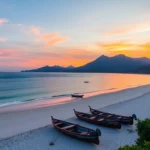Introduction to Lombok: Indonesia’s Hidden Gem
Nestled within the Indonesian archipelago lies a captivating island that remains a relatively undiscovered treasure for many travelers—Lombok. Known for its pristine beaches, towering volcanoes, rich cultural tapestry, and warm-hearted communities, Lombok offers a multifaceted experience that appeals to adventurers, cultural aficionados, and those seeking tranquil escapes alike. Despite its proximity to Bali, Lombok has maintained a sense of authenticity and natural untouched beauty that makes it a distinctive travel destination in Southeast Asia. This comprehensive guide aims to explore every facet of Lombok, from its geographical features to cultural practices, key tourism spots, practical travel tips, and curated experiences that can turn any visit into an unforgettable journey.
Geographical Overview of Lombok
Lombok is part of the Lesser Sunda Islands chain in Indonesia, situated east of Bali and west of Sumbawa. Covering an area of approximately 4,725 square kilometers, the island’s landscape is predominantly mountainous, characterized by rugged terrains, lush forests, and an extensive coastline dotted with stunning beaches. The island’s most iconic feature is Mount Rinjani, Indonesia’s second-highest volcano, standing at 3,726 meters above sea level. The volcano’s caldera hosts a scenic crater lake, Lake Segara Anakan, and the mountain itself plays a central role not only in the island’s geography but also in its cultural and spiritual identity.
Lombok’s geography fosters diverse ecosystems, from rainforests and waterfalls in the north to arid savannahs in the south. The island’s diverse topography creates microclimates that support a variety of flora and fauna, making it a haven for eco-tourism. The surrounding waters are equally impressive, with vibrant coral reefs, marine biodiversity, and idyllic islands like the Gili trio—Gili Trawangan, Gili Air, and Gili Meno—famous for their crystal-clear waters and abundant marine life.
Historical and Cultural Context
Lombok’s history is deeply intertwined with local indigenous traditions, chiefly rooted in the Sasak culture—the predominant ethnic group on the island. The Sasak people have maintained a rich cultural heritage, blending animist beliefs with Islamic practices introduced centuries ago. This fusion manifests vividly in their architecture, festivals, and daily rituals.
Historically, Lombok was a trading hub within the maritime Silk Road, facilitating cultural exchanges that enriched its identity. The island’s history also includes periods of Dutch colonial influence, which impacted its socio-political landscape. Despite these external influences, Lombok has preserved its traditional arts, crafts, and customs, making it a living museum of ancient traditions integrated with modern life.
In recent decades, the development of tourism has catalyzed economic growth, but the community’s cultural fabric remains vibrant. Visitors are encouraged to engage respectfully with local customs, such as traditional Sasak ceremonies, weaving practices, and culinary traditions, fostering meaningful intercultural exchange.
Why Lombok Stands Out in Southeast Asia
While Southeast Asia is dotted with renowned tourist destinations, Lombok distinguishes itself through its seamless blend of raw natural beauty, cultural authenticity, and adventure opportunities. Unlike Bali or Phuket, which are heavily commercialized, Lombok presents a more subdued, eco-conscious atmosphere that appeals to travelers seeking genuine experiences.
Lombok’s towering Rinjani volcano, unspoiled beaches, and vibrant local traditions offer a compelling contrast to the hustle of more developed resorts. The island’s commitment to sustainability and community-based tourism initiatives has cultivated a responsible travel environment. Moreover, Lombok’s relatively low visitor density ensures that attractions remain pristine, providing an ideal setting for eco-adventures, cultural immersions, and relaxation.
In addition, its strategic location allows easy access to the Gili Islands and other remote destinations, broadening the scope for multi-island exploration. Combining natural grandeur with cultural depth, Lombok emerges as an undiscovered jewel worth exploring in Southeast Asia’s vibrant tourism scene.
Top Attractions and Natural Landmarks in Lombok
Beaches and Islands: Gili Trawangan and Gili Air
The Gili Islands, comprising Gili Trawangan, Gili Air, and Gili Meno, are some of Lombok’s most celebrated natural attractions. These small islands have become synonymous with paradise—offering white sandy beaches, turquoise waters, and a laid-back ambiance. Gili Trawangan is known for its lively nightlife, vibrant underwater scenes, and water sports, while Gili Air provides a more tranquil setting suitable for families and romantic getaways.
Snorkeling and diving around the Gili islands reveal rich marine biodiversity, including sea turtles, reef sharks, and colorful coral reefs. The islands are also important nesting sites for sea turtles, emphasizing their ecological significance. Visitors can explore underwater via glass-bottom boats, PADI-certified dive centers, or simply relax on the pristine beaches.
Mount Rinjani: Indonesia’s Second Highest Volcano
Mount Rinjani stands as the focal point of adventure tourism in Lombok. For hikers and mountaineers, ascending Rinjani is a challenging but rewarding experience, offering vistas of the surrounding islands, crater lakes, and volcanic landscapes. The trek usually takes 2-3 days, with iconic stops including the Segara Anak crater lake and hot springs.
The Rinjani trek requires preparation, proper gear, and local guides, but the culmination—standing atop one of Indonesia’s most significant volcanoes—justifies the effort. The area around Rinjani is also home to diverse ecosystems and wildlife, making it an excellent spot for eco-tourism. It is recommended to plan this trek during the dry season (April to November) for optimal safety and experience.
Waterfalls and Marine Parks for Adventure Seekers
Lombok’s waterfalls, such as Sendang Gile and Tiu Kelep, attract visitors seeking nature’s tranquility and adventure. These cascades are nestled within lush forests in the northern part of the island and can be accessed via guided hikes or organized tours. Swimming in the cool waters beneath the waterfalls offers a refreshing break from tropical heat.
Marine parks like the Sekotong Marine Reserve and the Bangko-Bangko Reef are perfect for snorkeling, diving, and observing marine biodiversity. The vibrant coral reefs host an array of tropical species, making Lombok an ideal spot for underwater photography and eco-friendly diving adventures.
Cultural Experiences and Local Traditions in Lombok
Traditional Sasak Village Visits
Exploring Sasak villages, such as Sade and Sukarara, provides insight into ancient customs, weaving techniques, and daily life. Visitors can observe traditional architecture, participate in craft-making, and learn about the community’s historical livelihood centered around agriculture and weaving.
Sade Village, known for its traditional thatched houses and handwoven textiles, offers guided tours that highlight the community’s cultural heritage. Sukarara is renowned for its intricate textiles, where visitors can even try their hand at weaving traditional Sasak fabrics using centuries-old techniques.
Festivals and Religious Ceremonies
Lombok’s cultural calendar is punctuated with vibrant festivals, such as the Bau Nyale Festival—celebrating the legendary appearance of sea worms (Nyale), which are believed to be the reincarnation of Princess Mandalika. This event involves beach processions, fishing rituals, and communal feasts, providing immersive cultural experiences.
Islamic and local animist celebrations are integral to community life, showcasing traditional music, dances, and spiritual rituals. Visitors are encouraged to participate respectfully and observe customs that highlight Lombok’s spiritual diversity.
Local Handicrafts and Culinary Delights
The island’s rich arts and crafts scene is evident in its woven textiles, wood carvings, and pottery. Markets in Lombok display vibrant, handcrafted items ideal for souvenirs and supporting local artisans.
Lombok’s cuisine features coconut-based dishes, spicy sambals, fresh seafood, and traditional Sasak specialties like Plecing Kangkung (spicy vegetable salad) and Ayam Taliwang (grilled chicken). Food tours and cooking classes allow visitors to connect with local flavors and culinary traditions directly.
Travel Tips and Practical Information for Visiting Lombok
Best Time to Visit and Seasonal Highlights
The optimal period to visit Lombok is during the dry season, from April to November, when weather conditions favor outdoor activities and beach relaxation. The peak tourist months are July and August, so early bookings are advised. The rainy season, from December to March, can bring heavy showers, especially in the mountains, but it also offers lush scenery and fewer crowds.
Special events such as traditional festivals and cultural performances tend to align with local calendar dates, so checking scheduled events ahead of travel enhances your experience.
Getting Around: Transportation Options
Transport in Lombok primarily includes motorcycle rentals, private drivers, and public minivans (bajajs). For independent travelers, renting a scooter is cost-effective and flexible, suitable for exploring remote beaches and villages. However, safety and local driving regulations should be prioritized.
For longer distances or convenience, hiring a car with a driver is recommended, especially for tours to Mount Rinjani or venture into less accessible areas. Domestic flights connect Lombok’s Lombok International Airport (LOP) with major Indonesian hubs, primarily Jakarta and Bali.
Accommodations and Local Hospitality
Lombok offers a spectrum of accommodations, from luxury resorts and boutique hotels to budget hostels and homestays. The southern beaches and gili islands host high-end resorts with private villas and extensive amenities catering to luxury travelers. In contrast, traditional guesthouses and eco-lodges provide authentic cultural immersion at affordable rates.
Hospitality in Lombok is characterized by warmth and friendliness, with many establishments emphasizing environmental sustainability and community engagement. Booking in advance, especially during peak seasons, ensures availability and better rates.
Planning Your Lombok Adventure: Tours and Custom Experiences
Guided Tours to Volcanoes and Hidden Beaches
Expert-guided tours facilitate safe and enriching experiences exploring Lombok’s natural wonders. Volcano trekking expeditions are led by experienced guides, offering insights into volcanic geology and local legends. Many tour operators include equipment, permits, and acclimatization support, ensuring safety and comfort.
Customizable itineraries can incorporate visits to secret beaches, waterfalls, and less-visited temples, allowing travelers to discover hidden gems away from crowds.
Wildlife and Eco-Tours in Lombok’s Reserves
Eco-tourism initiatives focus on protecting Lombok’s unique ecosystems. Guided wildlife tours in conservation areas reveal endemic species and the island’s biodiversity. Birdwatching, mangrove exploration, and marine eco-tours promote environmental awareness and sustainable tourism practices.
Participating in volunteer programs or conservation activities offers travelers a chance to give back while deepening their connection to Lombok’s environmental legacy.
Custom Cultural and Culinary Packages
Travel agencies and local community partners offer bespoke experiences like traditional cooking classes, craft workshops, and cultural immersions. These packages typically include stays with local families, hands-on participation in traditional ceremonies, and visits to artisanal cooperatives, enriching your understanding of Lombok’s heritage.
Such tailor-made experiences foster authentic connections and unforgettable memories, making your journey truly personal and impactful.





